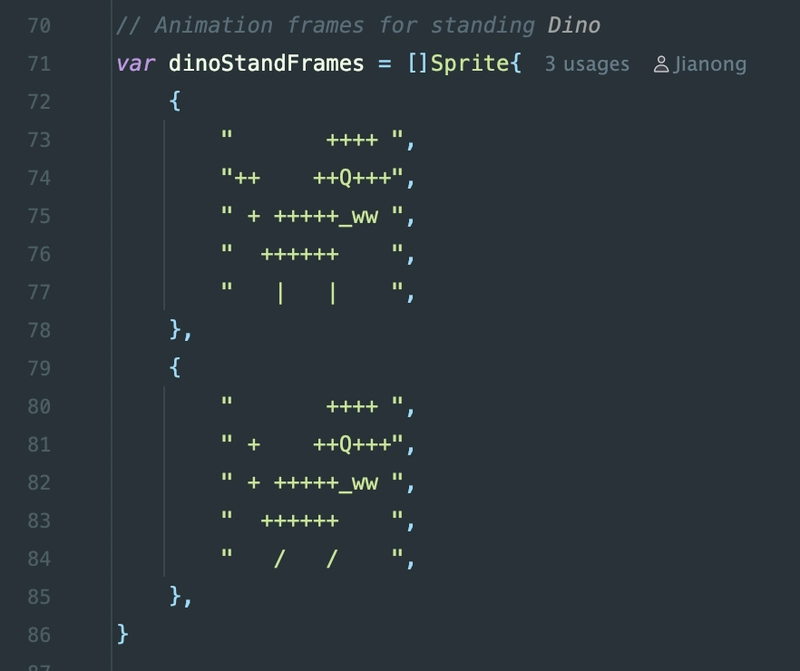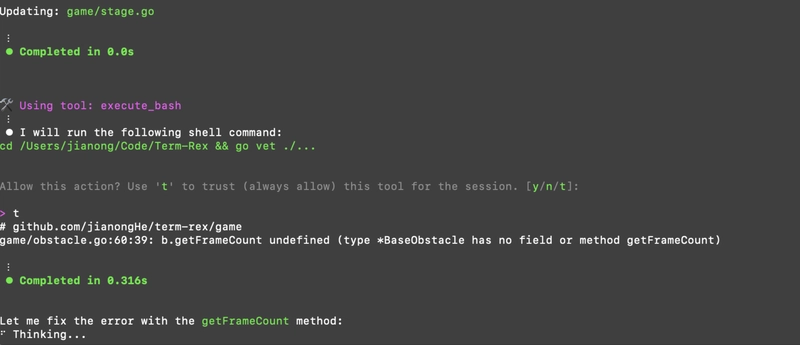This is a submission for the Amazon Q Developer "Quack The Code" Challenge: That's Entertainment! What I Built Yes. As you can see, this is the classic Chrome offline Dino Runner game, but in command-line version. I call it Term-Rex or -rex. What makes Term-Rex special is that Amazon Q Developer handled approximately 90% of the development work. From designing the game architecture to implementing complex game mechanics like collision detection, obstacle generation, and animation systems - Amazon Q was the driving force behind this project. Demo (no gif here so:) How to Play Term-Rex can be installed and played through multiple methods: Homebrew (macOS/Linux): brew install jianongHe/tap/term-rex term-rex NPM: npm install -g term-rex term-rex Scoop (Windows): scoop bucket add jianongHe https://github.com/jianongHe/scoop-bucket.git scoop install term-rex Direct Download Download the pre-built binary for your system from the releases page. Or you can directly clone my repo and go run main.go Game Controls: Key Action Space / ↑ Jump ↓ Duck P Pause/Resume R Restart (after game over) Q / Esc Quit Code Repository https://github.com/jianongHe/Term-Rex How I Used Amazon Q Developer Did you notice the dino's eye is a Q? Guess what? That means Amazon Q, haha. To be honest, 90% of this game's code was done by Amazon Q. I just described everything I wanted in the terminal, and it basically did the rest. What impressed me most about working with Amazon Q Developer was: Running in terminal: It can directly run commands in the terminal, which makes it way more powerful. That means it can access more system operations, helping me organize project structure and run other necessary commands much more easily. Contextual Understanding: Amazon Q understood basically the entire codebase and could make targeted improvements to specific components without breaking others. Problem-Solving: When I encountered issues with CI/CD pipelines or version synchronization, Amazon Q quickly diagnosed and resolved them. Code Quality: The code Amazon Q produced was clean, well-documented, and followed best practices - no spaghetti code or technical debt. Learning Opportunity: Working with Amazon Q taught me advanced Go programming techniques and game development patterns I wouldn't have discovered on my own. My journey with Term-Rex showcases the transformative power of Amazon Q Developer in game development. It only took me about 24 hours to finish this game Here's how Amazon Q revolutionized my workflow: 1. Architecture Design & Project Setup I started with a simple prompt: "Help me create a terminal-based dinosaur runner game in Go." Amazon Q immediately: Designed a comprehensive game architecture with proper separation of concerns Set up the project structure with all necessary files and modules Implemented the game loop with proper timing and frame rate control Created a clean, maintainable codebase following Go best practices: 2. Game Implementation Amazon Q Developer implemented sophisticated game core logic that would have taken me weeks to code: Flexible animation system that handles sprite transitions for the dinosaur and obstacles The collision detection algorithm (running, jumping, ducking). Added a cloud system with different cloud types moving at varying speeds Implemented ground decorations for visual depth Help me to design ASCII art for all game elements: 3. Cross-Platform Distribution Amazon Q helped me make Term-Rex available everywhere: Created installation scripts for Homebrew, NPM, and Scoop(Windows) Set up GitHub Actions workflows for automated releases Ensured the game runs consistently across different terminal types It can even automatically help me push codes to github: Conclusion During this short development experience this weekend in this project, I discovered that I've genuinely come to enjoy using Amazon Q. Initially, I thought it was just another LLM client similar to ChatGPT or Gemini, but after getting hands-on experience, I realized it can do so much more. With well-crafted prompts, it can fully function as a "senior developer" to assist your development process. It automatically creates necessary files, implements clean and readable object-oriented code, and even runs go vet to validate code correctness. If there are any issues, it continuously works to fix them: I believe it significantly enhances development efficiency and reliability, especially when working with strongly-typed languages like golang. Of course, it does have drawbacks, So far I think its biggest flaw is - the dreaded reached max tokens error, haha: Thanks for reading! Feel free to try this classic mini-game. Note: You don't need to be offline to play it! █████╗ ███╗ ███╗ █████╗ ███████╗ ██████╗ ███╗ ██╗ ██████╗ █

This is a submission for the Amazon Q Developer "Quack The Code" Challenge: That's Entertainment!
What I Built
Yes. As you can see, this is the classic Chrome offline Dino Runner game, but in command-line version. I call it Term-Rex or
What makes Term-Rex special is that Amazon Q Developer handled approximately 90% of the development work.
From designing the game architecture to implementing complex game mechanics like collision detection, obstacle generation, and animation systems - Amazon Q was the driving force behind this project.
Demo (no gif here so:)
How to Play
Term-Rex can be installed and played through multiple methods:
Homebrew (macOS/Linux):
brew install jianongHe/tap/term-rex
term-rex
NPM:
npm install -g term-rex
term-rex
Scoop (Windows):
scoop bucket add jianongHe https://github.com/jianongHe/scoop-bucket.git
scoop install term-rex
Direct Download
Download the pre-built binary for your system from the releases page.
Or you can directly clone my repo and go run main.go
Game Controls:
| Key | Action |
|---|---|
| Space / ↑ | Jump |
| ↓ | Duck |
| P | Pause/Resume |
| R | Restart (after game over) |
| Q / Esc | Quit |
Code Repository
https://github.com/jianongHe/Term-Rex
How I Used Amazon Q Developer
Did you notice the dino's eye is a Q? Guess what? That means Amazon Q, haha.
To be honest, 90% of this game's code was done by Amazon Q. I just described everything I wanted in the terminal, and it basically did the rest.
What impressed me most about working with Amazon Q Developer was:
Running in terminal: It can directly run commands in the terminal, which makes it way more powerful. That means it can access more system operations, helping me organize project structure and run other necessary commands much more easily.
Contextual Understanding: Amazon Q understood basically the entire codebase and could make targeted improvements to specific components without breaking others.
Problem-Solving: When I encountered issues with CI/CD pipelines or version synchronization, Amazon Q quickly diagnosed and resolved them.
Code Quality: The code Amazon Q produced was clean, well-documented, and followed best practices - no spaghetti code or technical debt.
Learning Opportunity: Working with Amazon Q taught me advanced Go programming techniques and game development patterns I wouldn't have discovered on my own.
My journey with Term-Rex showcases the transformative power of Amazon Q Developer in game development. It only took me about 24 hours to finish this game Here's how Amazon Q revolutionized my workflow:
1. Architecture Design & Project Setup
I started with a simple prompt: "Help me create a terminal-based dinosaur runner game in Go." Amazon Q immediately:
- Designed a comprehensive game architecture with proper separation of concerns
- Set up the project structure with all necessary files and modules
- Implemented the game loop with proper timing and frame rate control
- Created a clean, maintainable codebase following Go best practices:
2. Game Implementation
Amazon Q Developer implemented sophisticated game core logic that would have taken me weeks to code:
- Flexible animation system that handles sprite transitions for the dinosaur and obstacles
- The collision detection algorithm (running, jumping, ducking).
- Added a cloud system with different cloud types moving at varying speeds
- Implemented ground decorations for visual depth
- Help me to design ASCII art for all game elements:
3. Cross-Platform Distribution
Amazon Q helped me make Term-Rex available everywhere:
- Created installation scripts for Homebrew, NPM, and Scoop(Windows)
- Set up GitHub Actions workflows for automated releases
- Ensured the game runs consistently across different terminal types
- It can even automatically help me push codes to github:
Conclusion
During this short development experience this weekend in this project, I discovered that I've genuinely come to enjoy using Amazon Q. Initially, I thought it was just another LLM client similar to ChatGPT or Gemini, but after getting hands-on experience, I realized it can do so much more.
With well-crafted prompts, it can fully function as a "senior developer" to assist your development process. It automatically creates necessary files, implements clean and readable object-oriented code, and even runs go vet to validate code correctness. If there are any issues, it continuously works to fix them:
I believe it significantly enhances development efficiency and reliability, especially when working with strongly-typed languages like golang.
Of course, it does have drawbacks, So far I think its biggest flaw is - the dreaded reached max tokens error, haha:
Thanks for reading! Feel free to try this classic mini-game.
Note: You don't need to be offline to play it!
█████╗ ███╗ ███╗ █████╗ ███████╗ ██████╗ ███╗ ██╗ ██████╗
██╔══██╗████╗ ████║██╔══██╗╚══███╔╝██╔═══██╗████╗ ██║ ██╔═══██╗
███████║██╔████╔██║███████║ ███╔╝ ██║ ██║██╔██╗ ██║ ██║ ██║
██╔══██║██║╚██╔╝██║██╔══██║ ███╔╝ ██║ ██║██║╚██╗██║ ██║▄▄ ██║
██║ ██║██║ ╚═╝ ██║██║ ██║███████╗╚██████╔╝██║ ╚████║ ╚██████╔╝
╚═╝ ╚═╝╚═╝ ╚═╝╚═╝ ╚═╝╚══════╝ ╚═════╝ ╚═╝ ╚═══╝ ╚══▀▀═╝













































































































































































![[The AI Show Episode 156]: AI Answers - Data Privacy, AI Roadmaps, Regulated Industries, Selling AI to the C-Suite & Change Management](https://www.marketingaiinstitute.com/hubfs/ep%20156%20cover.png)
![[The AI Show Episode 155]: The New Jobs AI Will Create, Amazon CEO: AI Will Cut Jobs, Your Brain on ChatGPT, Possible OpenAI-Microsoft Breakup & Veo 3 IP Issues](https://www.marketingaiinstitute.com/hubfs/ep%20155%20cover.png)




































































































































































































































































_incamerastock_Alamy.jpg?width=1280&auto=webp&quality=80&disable=upscale#)
_Brain_light_Alamy.jpg?width=1280&auto=webp&quality=80&disable=upscale#)






























































































![Senators reintroduce App Store bill to rein in ‘gatekeeper power in the app economy’ [U]](https://i0.wp.com/9to5mac.com/wp-content/uploads/sites/6/2025/06/app-store-senate.jpg?resize=1200%2C628&quality=82&strip=all&ssl=1)



























































































